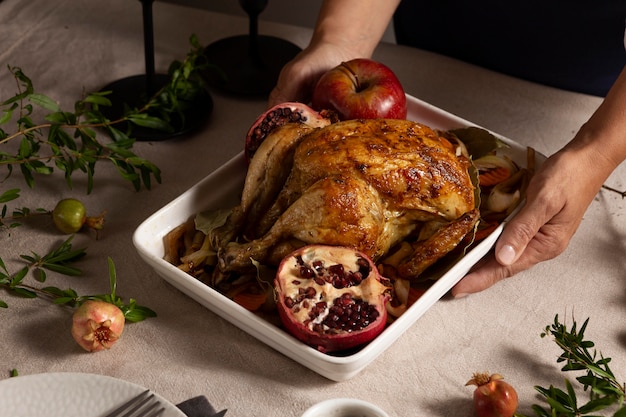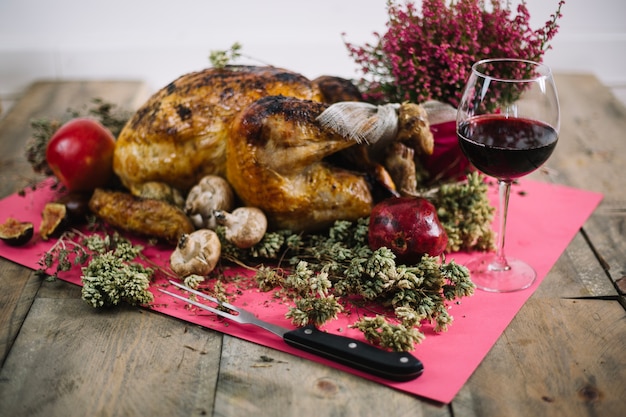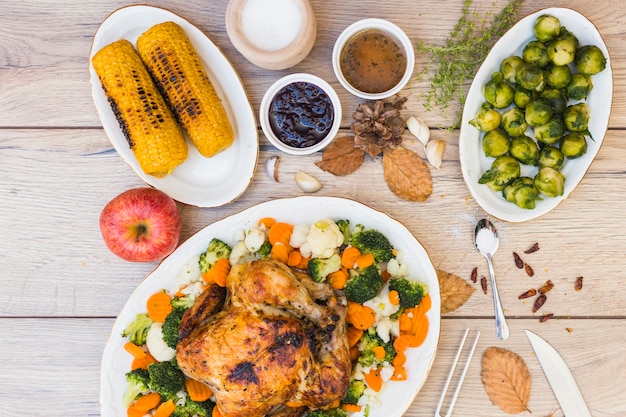Ah, stuffing. The glorious, savory companion to a roast turkey, a dish that sparks debates in kitchens across the globe. Is it cooked inside the bird or separately? Sage or no sage? Bread-based or veggie-stuffed? It's a culinary puzzle that demands a comprehensive guide, don't you think?
So, gather 'round, dear reader, and let's embark on a journey into the heart of stuffing – a journey that'll equip you with the knowledge to create a dish that’s not just good, but truly outstanding. We'll delve into the secrets of crafting the perfect texture, explore a world of flavour combinations, and even tackle the age-old stuffing debate.
(Part 1) The Foundations of Great Stuffing

The Essence of Stuffing: A Symphony of Texture and Flavour
First, let's consider what makes stuffing so irresistible. For me, it's the harmonious interplay of textures and flavours. Imagine the soft, pillowy bread soaked in rich broth, the contrasting crunch of nuts or herbs, and the savory depth of spices – it's a delightful culinary experience.
The Bread: The Cornerstone of a Delicious Stuffing
Now, let's talk bread. It's the very foundation of most stuffing, so choosing the right kind is paramount. We want a bread that can absorb broth without becoming mushy. That's why I favour day-old bread – it's got a sturdiness that holds up beautifully. A crusty baguette or good ol' sourdough are fantastic choices. Those crusty edges contribute a lovely texture, and the staleness prevents the stuffing from getting soggy.
The Broth: The Key to a Symphony of Flavours
Let's not underestimate the importance of broth. This liquid is the conduit for flavor, so it deserves attention. My go-to choice is homemade chicken or turkey broth, but you can easily adapt it for vegetarian needs with a vegetable broth. Don't be afraid to get creative! A splash of wine or some chopped herbs can add a delightful layer of complexity.
(Part 2) The Art of Building Flavour

Beyond the Basics: Unleashing a World of Flavor Possibilities
Now we're getting into the fun part, where you can truly personalize your stuffing. Think of it like a blank canvas waiting for your culinary artistry. Here are some of my personal favourite ingredients that elevate stuffing to new heights:
Sausage: It's a classic addition for a meaty kick, and it complements the bread beautifully. I favour italian sausage, but chorizo or even ground beef can work wonders.
Herbs: Fresh herbs are essential for adding brightness and aroma. Thyme, rosemary, sage, and parsley are all great choices. Experiment with combinations and discover what speaks to your palate.
Onions and Celery: This iconic duo, the foundation of a classic mirepoix, brings depth and complexity to the stuffing. Don't forget to sauté them before adding them for a richer flavour.
Nuts: Chopped pecans, walnuts, or even almonds add a satisfying crunch and nutty flavour.
Dried Fruits: A touch of dried cranberries, apricots, or raisins adds a welcome sweet and tangy note that balances the savory flavours.
(Part 3) The Stuffing Showdown: Inside or Out?

The Great Debate: Inside the Bird vs. Separate Baking
Ah, the age-old question: Should stuffing be cooked inside the turkey or baked separately? It's a topic that's sparked heated discussions in kitchens across the globe.
Inside the Bird: Tradition with a Note of Caution
Stuffing the turkey is a classic tradition, but it's important to be cautious. You need to ensure the stuffing cooks to a safe internal temperature of 165°F (74°C) to avoid foodborne illnesses. If the stuffing isn't cooked properly, it can become a breeding ground for bacteria.
Separate Baking: Safety and a World of Flavor Control
Personally, I prefer to bake the stuffing separately. It gives me more control over the cooking process, ensuring it cooks evenly and develops a beautiful golden-brown crust.
Tips for Cooking Stuffing Separately
Use a shallow baking dish: This helps the stuffing cook evenly and achieve that glorious golden crust.
Don't overfill the dish: Leave some space at the top so the stuffing can expand as it cooks.
Cover the dish: This helps the stuffing cook evenly and prevents the top from drying out.
Check the internal temperature: Make sure the stuffing reaches a safe internal temperature of 165°F (74°C).
(Part 4) The Stuffing Recipe: My Family Favourite
My Go-To Stuffing Recipe: A Taste of Home
Enough of the theory, let's get down to the nitty-gritty. Here's my go-to stuffing recipe, a family favourite that has been passed down through generations. It's a classic bread stuffing with a subtle sweetness from dried cranberries and a warm touch of sage.
Ingredients:
1 (1-pound) loaf of day-old sourdough bread, cubed
1/2 cup butter, melted
1 large onion, chopped
2 celery stalks, chopped
1/2 cup dried cranberries
1 teaspoon dried sage
1/2 teaspoon salt
1/4 teaspoon black pepper
1 cup chicken or turkey broth
1/2 cup chopped pecans (optional)
Instructions:
1. Preheat oven to 350°F (175°C).
2. In a large bowl, combine the bread cubes, melted butter, onion, celery, cranberries, sage, salt, and pepper.
3. Add the chicken or turkey broth and stir until the bread is well moistened.
4. If using pecans, fold them in gently.
5. Transfer the stuffing to a greased 9x13 inch baking dish.
6. Bake for 30-40 minutes, or until the stuffing is golden brown and heated through.
(Part 5) Stuffing Variations: Beyond the Classics
The World of Stuffing Flavour: Exploring New Possibilities
You've mastered the basics, now it's time to get creative! Here are a few flavour variations that will inspire your culinary journey:
Cheesy Stuffing: For a cheesy kick, add 1/2 cup grated cheddar cheese to your stuffing mixture.
Savoury Stuffing: Add 1/2 cup crumbled sausage to your stuffing mixture for a heartier, more savoury flavour.
Apple Sage Stuffing: For a sweet and savoury twist, add 1/2 cup diced apple and a tablespoon of fresh sage to your stuffing mixture.
wild rice Stuffing: Swap out the bread for cooked wild rice for a nutty, protein-packed variation.
Cornbread Stuffing: Replace the sourdough bread with cornbread crumbs for a sweeter, Southern-inspired stuffing.
(Part 6) The Ultimate Stuffing Tips
Tips and Tricks for Stuffing Success: Avoiding the Common Pitfalls
Stuffing can be a bit fickle, so here are some tips to ensure your next batch is a resounding success:
Don't overstuff the turkey: If you're stuffing the bird, make sure to leave plenty of space for the stuffing to expand. It should only fill about 2/3 of the cavity.
Keep an eye on the temperature: Whether you're stuffing the bird or baking separately, make sure the internal temperature of the stuffing reaches 165°F (74°C) to ensure it's cooked through.
Let the stuffing rest: Once the stuffing is cooked, let it rest for 10-15 minutes before serving. This will allow it to absorb the flavours and become more moist.
Don't be afraid to experiment: This is your chance to showcase your culinary creativity! Feel free to add your favourite ingredients and spices.
(Part 7) Leftover Stuffing: A Delicious Second Act
Leftover Stuffing: Don't Throw it Away!
Leftover stuffing? Don't even think about throwing it away! It's a delicious opportunity for culinary creativity. Here are a few ideas to transform those leftovers into a delightful second act:
Stuffing Balls: Form the leftover stuffing into balls, dip them in egg wash, then breadcrumbs, and fry them until golden brown.
Stuffing Casserole: Layer the leftover stuffing in a baking dish with a sauce of your choice (think cream of mushroom soup or tomato sauce) and bake until bubbly.
Stuffing Fritters: Combine the leftover stuffing with an egg and some flour, then fry it in a pan until golden brown.
Stuffing Salad: Combine the leftover stuffing with chopped vegetables, herbs, and a dressing of your choice for a refreshing salad.
(Part 8) The Stuffing Debate: A Look at Different Traditions
Beyond the Basics: A Global Look at Stuffing
You know, stuffing isn't just a British thing. It's enjoyed across the globe, with variations found in different cultures and regions. Let's take a quick trip around the world:
American Stuffing: Typically made with bread cubes, broth, herbs, and vegetables.
French Stuffing: Often called "farce," it's typically made with bread, sausage, mushrooms, and herbs.
Italian Stuffing: "Ripieno" is a stuffing made with rice, sausage, herbs, and often cheese.
German Stuffing: Known as "Füllung," it's typically made with bread, sausage, onions, and dried fruits.
(Part 9) The Stuffing Table: A Quick Reference
A Quick Reference Guide to Different Types of Stuffing:
To give you a clearer picture of the variety of stuffings out there, here's a quick table summarizing some common variations:
| Type of Stuffing | Key Ingredients | Characteristics |
|---|---|---|
| Bread Stuffing | Bread, broth, herbs, vegetables | Classic, versatile, can be adapted to various flavours |
| Cornbread Stuffing | Cornbread crumbs, broth, herbs, vegetables | Sweet and savory, with a Southern flair |
| Wild Rice Stuffing | Wild rice, broth, vegetables, herbs | Hearty, nutty, and protein-packed |
| Sausage Stuffing | Bread, sausage, herbs, vegetables | Meaty, savory, with a bold flavor |
| Vegetarian Stuffing | Bread, vegetable broth, herbs, vegetables | Plant-based, flavorful, and often includes nuts or dried fruit |
(Part 10) FAQs: Your Stuffing Questions Answered
FAQs: Clearing Up the Stuffing Mysteries
I've gathered some common questions about stuffing that you might be wondering about. Here are the answers to help you conquer your next stuffing adventure:
1. Can I use fresh bread for stuffing?
You can, but it's best to use day-old bread as it will absorb the broth better without becoming too soggy.
2. What if my stuffing is too dry?
Add a little more broth to the mixture until it reaches the desired consistency.
3. How long can I keep leftover stuffing?
Leftover stuffing can be stored in the refrigerator for up to 3-4 days. Reheat it in the oven or microwave until heated through.
4. Can I freeze leftover stuffing?
Yes, you can freeze leftover stuffing for up to 2 months. Thaw it in the refrigerator overnight before reheating.
5. What are some good sides to serve with stuffing?
mashed potatoes, gravy, cranberry sauce, and green beans are all classic sides that pair well with stuffing.
Well, there you have it! This comprehensive guide is your ultimate roadmap to crafting a delicious stuffing that will impress your guests and warm your heart. Remember, stuffing is a canvas for culinary creativity, so embrace experimentation and discover your own unique flavour combinations. Happy stuffing!
Everyone is watching

Corn on the Cob: The Ultimate Guide to Perfectly Cooked Ears
Healthy MealsAh, corn on the cob. Just the name evokes images of sunny days, barbecues, and that sweet, juicy flavour that ...

Perfect Pork Roast Oven Cooking Time: A Guide to Delicious Results
Healthy MealsThere's something truly satisfying about a perfectly roasted pork. The aroma alone is enough to make your mout...

Ham Cooking Time: How Long to Bake, Smoke, or Boil a Delicious Ham
Healthy MealsAh, ham. It's a classic, isn't it? A real crowd-pleaser, especially around holidays. And when done right, it'...

Scallops: The Ultimate Guide to Perfect Cooking
Healthy MealsAh, scallops. Those delicate, sweet, and utterly delicious morsels of the sea. They hold a special place in my...

Spaghetti Squash: The Ultimate Guide to Cooking and Serving
Healthy MealsRemember that time you saw spaghetti squash at the supermarket, looking all bumpy and strange, and thought, "W...
